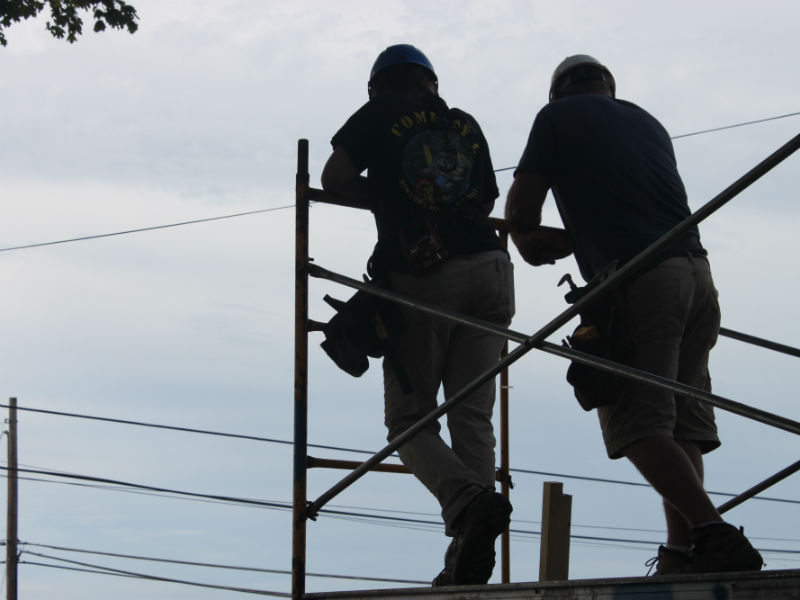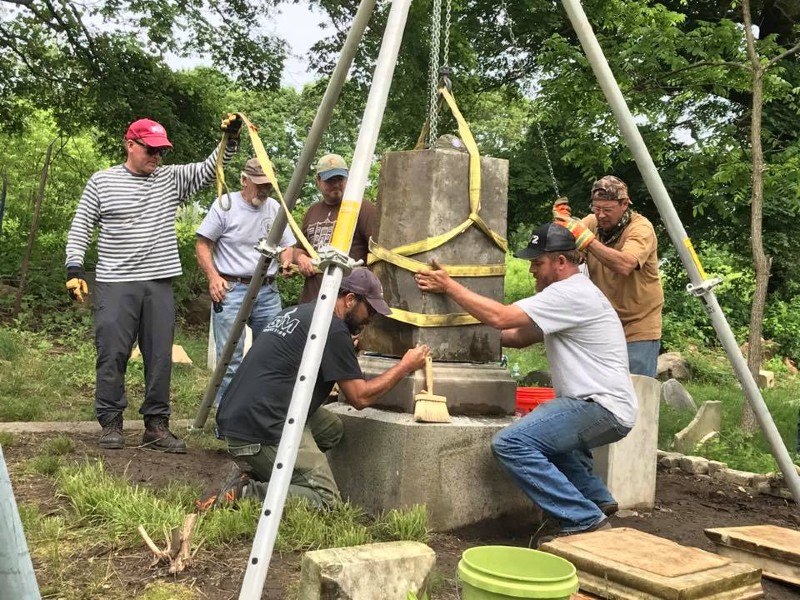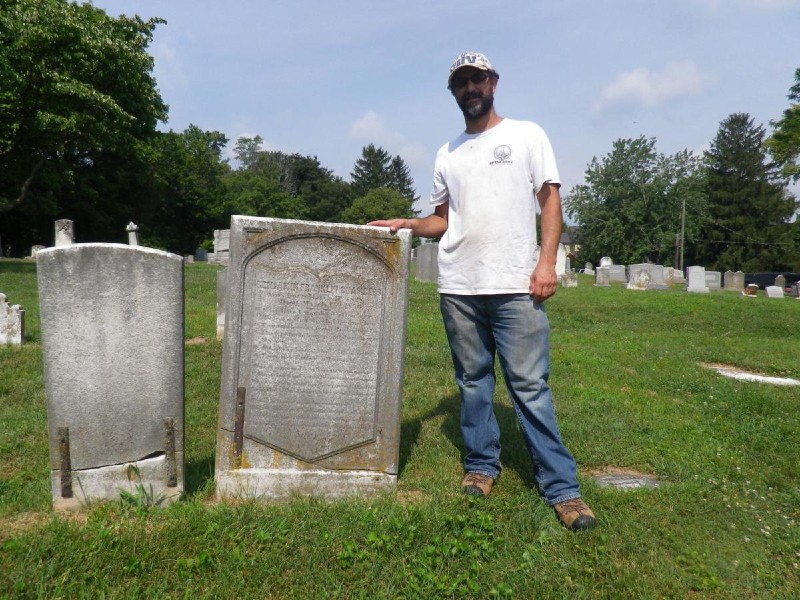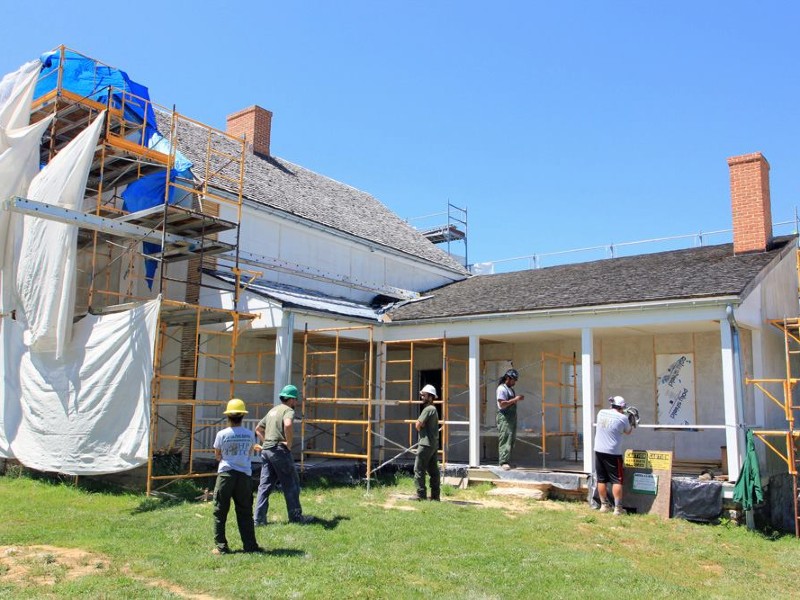Saving the historic fabric of America’s National Parks is a massive job – and it requires a wide range of skills. Teaching those skills and passing down the historic trades within the National Park Service is the responsibility of the National Historic Preservation Training Center. Today’s guest on PreserveCast is Moss Rudley, Superintendant of the Training Center to discuss the unique Center and their effort to train America’s next generation of historic tradespeople.
LISTEN TO THE EPISODE
READ THE CONVERSATION
[Intro] Saving the historic fabric of America’s national parks is a massive job, and it requires a wide range of skills. Teaching those skills, and passing down the historic trades within the National Park Service is the responsibility of the National Historic Preservation Training Center. Established in 1977, and headquartered in Frederick, Maryland, the center is the Parks Service’s premier preservation training center. Today’s guest, Moss Rudely, is the superintendent of the center and a historic mason by training. And in 2018, Preservation Maryland signed an agreement with the center to launch a new initiative, The Campaign for Historic Trades, which is designed to expand the Center’s apprenticeship program. So grab your safety goggles and hammer because, on this week’s PreserveCast, we’re talking about the role of this unique Center and their efforts to train America’s next generation of historic tradespeople. [Intro]
[Music] From Preservation Maryland’s studios in the historic podcast district of Baltimore, this is PreserveCast. [Music]
[Host] Before we start this week’s episode, I really want to thank you for listening, and I want to ask for your help. PreserveCast is powered by Preservation Maryland, a non-profit organization that depends on member contributions to fund its work. This podcast receives no government support and currently has no major funder support. Its budget is entirely dependent on listener contributions. I’m hoping you’ll consider making a quick gift to help support this podcast which is bringing important preservation stories to thousands of listeners around the country. Think of us as your preservation Netflix. Any amount helps, and you can make a quick online donation by going to preservecast.org and clicking the Donate Now button in the upper right-hand corner. We greatly appreciate it. Now, let’s get preserving. [Host]
[Nick Redding] This is Nick Redding, you’re listening to PreserveCast. Today we’re joined by Moss Rudely, who is a native of Greenbrier County, West Virginia, where he was raised on a working cattle farm filled with historic vernacular structures. He was first exposed to the trades and the field of historic preservation through the care of hand-hewn log structures of the Scotts, Irish, and German. A graduate of Shepherd University in Shepherdstown, West Virginia, he’s been with the National Parks Service’s Historic Trades Training Center since 2000. A historic mason by training, after over 17 years at the center, he was promoted to superintendent in 2017. Moss, it’s a pleasure to have you with us here today on PreserveCast.
[Moss Rudley] Well, thank you. It’s a pleasure to be here.
[NR] So you have a really interesting background and sort of your path to preservation. Tell people, how did you get into this? Were you always into historic buildings? And when did you decide that you really wanted to kind of do the work that you do today?

Moss Rudley, center, at Shafer Farm, Burkittsville, MD, 2017.
[MR] Well, I think it all started with my father. And kind of a hobby or passion of his was – he moved to West Virginia and got a log cabin and was living in it. And from there, he took a job with the SHPO (State Historic Preservation Offices) doing surveys of historic settlement cabins and cabins up in the Hollows. And he would drag me around on those visits to these kind of old settlement sites that are very vernacular and did sketches of the properties and the buildings. And then from there, he kind of gained an affinity for log cabins. And along the way, people would say, “Well, if you want it, you can just come and tear it down. I’d like to have it gone.” So he started collecting these buildings on our farm. And it was a working cattle farm.
There’s never enough buildings, so he really got into, in some ways, collecting historic log cabins and saving them. Some got repurposed and put together as different types of structures only because of the decay. So that’s really where I got my start in it and kind of, “Okay, old buildings are cool.”
And then when I was in high school, he actually tore down a log cabin that somebody had given to him, and he decided that he was going to rebuild it overseas. So he put it in a shipping container and sent it to Israel. So I’ve been exposed to these types of historic structures. And then kind of went to college. Shephard University was the college at that time. And basically, I was an engineering major. Was going to be a structural engineer. And went through that program and kind of had a change of heart and thought and finished out – I ended up getting a little sidebar and got a degree in culinary arts, and then came back to this world of preservation and happened to look at it again from a different perspective and a career. And actually found a local contractor who was trained by the National Trust for Historic Preservation, David Gibney, and just reached out to him and asked for a job and got a job as a trade worker. And really from there started my career path in historic preservation, and from there it took me to do park service.
[NR] So I have to ask you – it sounds pretty cool what your dad put together. Are all the structures still there? Is that farm still in the family?
[MR] Oh yes. It is still in the family. There are, I think, 17 log structures there. And the one that we sent to Israel we rebuilt and actually donated to a kibbutz over there. So yeah, they’re all still around.
[NR] Wow. 17 log structures. That’s got to be – that might be a record. That’s pretty impressive.
[MR] Yep. If you’ve ever been to Virginia City, Montana, it kind of reminds me of that place.
[NR] Okay. Very cool. So you worked for David Gidney, who, in the Mid-Atlantic, is sort of a legend in historic preservation. Has worked on a lot of important historic structures. And then you make the transition to working for the National Park Service in 2000. And what did you start doing there? What was your first gig with the park service?
[MR] I was actually hired as just a maintenance worker, so I was a laborer and trade worker in their carpentry division. And it was where I had my skills in log work and those aspects of doing the repairs and stuff on those cabins. So I got into that division, and in about 2004 I was accepted into the exhibit specialist training program. And so that started my acceleration into project leadership, design, execution of preservation work from a kind of project management and overall trade perspective.
[NR] And you work primarily in the masonry division?
[MR] So I did. From there, I took a lot of opportunities to apprentice under the historic masons at HPTC (Historic Preservation Training Center). And when I was accepted into the exhibit specialist training program, I entered that in the masonry division.
- Moss Rudley working on a historic monument.
- Moss Rudely at Harper Cemetery, WV. Photo by Frederick News-Post.
[NR] And so tell us a little bit about – I mean, people may be familiar with sort of just general modern-day masonry. I mean, is it similar? Is it more challenging? What is it like to train to be a historic mason? What did that process look like, and how does it compare to what people might be familiar with modern-day masonry?
[MR] With modern-day masonry, there are a lot of correlating and transferable knowledge and skills between the two. Somebody can come in from either end of that spectrum. But you’re still laying up and working with mortar, you’re still using units, whether they be stone or concrete block, and you’re still staying within the trade.
The difference comes when you specialize in historic masonry, things like solid wall construction, the materials that are used in both from a unit perspective, the bricks or the stone or the various types of materials, are all different and not readily available to match what’s historically there.
Engineers today have to transfer to, in the modern specs, a lot more standardized building systems that are harder for engineers to put their stamp and provide the necessary liability and compliance or codes that are required today. So you have to learn the nuances of that. You have to understand certain elements of a building are part of the character and may not actually need repairing or have a certain patina that is allowable, what wouldn’t happen in modern masonry.
What I do see is a very transferable part are the trowel skills, the hand skills, and those associated aspects. So someone who’s only trained in modern masonry, those hand skills and the understanding of using a level, the line, plumbing, some of those skills are transferred into doing historic work, it’s just in a different type of building system.
- Traditional Trade Apprenticeship Program students learning masonry. Photo by National Preservation Training Center.
- Traditional Trade Apprenticeship Program students learning masonry. Photo by National Preservation Training Center.
[NR] So you have been with the Historic Preservation Training Center, and that’s where you learned this work and then have transitioned into leadership roles and are now the Superintendent of the Center. But you’ve been there since 2000. Why don’t you give people a sense who maybe aren’t familiar with it? What is the National Historic Preservation Training Center? Sort of paint a picture of where you guys are located and what kind of work you do and what your mission is…
[MR] So, yeah. Thank you. It’s always a great opportunity to explain what HPTC does and where we came from. So, being a Historic Preservation Training Center, the history of it is we were born out of a dual crisis in some ways. It was a national disaster. Hurricane Agnes came up through the Potomac rivershed and damaged a lot of historic resources up the C&O Canal. At the same time, a project manager came on to manage those projects for the National Park Service that realized that there weren’t necessarily skills available to work on these historic structures anywhere in the local area, must less through a Park Service.
So he recognized a real skill gap in the trades, especially trades around historic trades, timber framing, shingle roofing, stonework, masonry, these aspects and bringing them together. So he was very bold at the time and decided to say, “Okay, well, I am going to – instead of just finding a contractor to try to do this, I’m going to start bringing people in and training them, finding the resources to train them, and then letting them perform the work and building capacity and skill across the board.”
Now, that was in 1977. In many ways, you fast-forward 40 years plus, and the situations are very similar. The natural disasters that hit – Maria and Irma – a year and a half, almost two years ago, highlighted almost an identical need. We find it reoccurring all over the country is that, as our building stock ages, as we try to keep that cultural heritage alive, we’re not developing people around the trades and, more importantly for those aspects, the historic trades.
So the Historic Preservation Training Center, as it currently stands, operates a large full-scale construction operation preservation services where we utilize preservation projects that the National Park Service need on their historic structures, and use those as a classroom to train a variety of different individuals during the course of that project. We’re training project leaders and project management in how to properly develop scopes to work, estimates, material needs, sourcing material, time it takes to do work. From there, we’re training different various grades of tradesmen. So there’s always a master tradesman associated with all of our divisions. From there, they sequentially go down in years of experience. We have tradesmen with 35,-40 years of experience, and you go down the line and you have your lowest and newest which would be youth interns and intakes, getting just an experience, a taste of that. So in that course, we do all this fee-for-service. So the project pays for the development of the people much like historic apprenticeship programs. So that’s how we operate. We do about 50 projects a year at probably around 25 to 30 National Parks. We also do partner with other federal agencies and non-profit, local, state, and government, to perform work on their structures as well as – sometimes, along the way we do provide independent skills training. But more of it is captured in the projects.

Traditional Trades Apprenticeship Program participants in Tennessee, 2019..
[NR] So tell us a little about – you mentioned 25-30 parks. Where are you working right now? Just kind of give people a sense for the scope and maybe where are you working and the types of projects that you guys are working on?
[MR] So of our divisions, we have a masonry, carpentry, and a wood crafting division. We also operate a small architecture and project management division. So currently, on masonry division is repairing and resetting the capstones at Fort McHenry in Baltimore. They are finishing up a project in Saint Croix in Fort Christiansvaern. They’re working at Catoctin Mountain Furnace at Camp Greenman, I believe. They’re also in a project at the C&O Canal around Round Top Cement Mill. They’ll be doing Vanderbilt, home of Franklin Rosevelt. They’ll be doing a little work in Harpers Ferry along the year. So there’s a good bit of work close to home in this kind of environment for the masonry section. Our carpentry section, they’re finishing up some work at Fort Pulaski. They’re also finishing up some work at Catoctin Mountain Furnace. We do have a wood crafting division that is working at Arlington National Cemetery. They’re working at Saint-Gaudens National Historic Site in Cornish, New Hampshire. They are finishing up some windows for the White House and getting ready to embark on a project at Harpers Ferry National Historic site.
[NR] So, I mean, at some point, HPTC, if it’s historic, it’s in the Park Service, there’s probably a good chance that you guys have touched it.
[MR] Yes, there is quite a bit of scale in that we work pretty much for any region, any park. We’re in discussions about some project training work at [USS] Ballard Pacific Pearl Harbor. We have a lot of parks that use our services re-occuringly. On an annual basis, multiple projects and those tend to be parks within a couple-hour vicinity of us. So the Harpers Ferrys, the Antietams, the Washington, DC, parks. We all have a really good working relationship that allows for good training opportunities, but also good work opportunities.
[NR] Oh, I was going to say, speaking of good work opportunities, we’re working on something together. Preservation Maryland in partnership with the HPTC has launched a charitable partnership called The Campaign for Historic Trades, which is focused on trying to expand in particular a variety of different things that you guys work on. But, specifically, the Traditional Trades Apprenticeship Program, which might be an interesting thing for you to talk a little bit about, about what you guys call TTAP, but the Traditional Trades Apprenticeship Program. So in terms of work experience and getting people into the field and training the next generation, what is that apprenticeship program? What does it look like and what kind of projects are those folks who are engaged in that program working on?
[MR] Thank you. Yeah, recognizing the next generation, looking at the Park Service, and I think this mirrors across the country in a lot of respects. The median age of the maintenance employees at the Park Service are around 54 years of age. And how do we engage a new generation, make something modern, but still stick with the idea of work progression and the apprenticeship model?
So the Traditional Trades Apprenticeship Program is, at its current state, is a youth and veteran intake program that serves youth from 18 to 30 and veterans from 18 to 35. And they go through a six-month pre-apprenticeship that will provide them with a good introduction into historic trades, historic preservation, as well as things like communication, workability, employability.
As part of that program, we have designed a three-day introduction to historic preservation primer that’s very interactive, it’s hands-on. It has electronic modules, but it also relates to the trades and why you preserve historic structures. Especially related to the Secretary of the Interior standards. The second part of that is the seven-day National Center for Construction Education and Research (NCCER) core craft construction curriculum. And that is a nationally recognized, an accredited certification program that high school vo-tech programs, college vocational programs utilize to teach trades education. And that is basically – at the end of the six months and you pass this NCCER test. It is proctored, it does have a test and requires some effort on the parts of participants. You have a nationally recognized certification. And you can leave the program and go to a – say you wanted to be an electrician. You have your career requisites done. You’re ready to get to the meat of that training. Or if you want to just get a job with the construction company, you have your safety card check. They know the curriculum that you’ve gone through and can vouch for – you have something to vouch for what you know and the skills you have.
[NR] And you’re also, at the end of this program, eligible for non-competitive federal hiring. So you could also go into the federal service too if you really wanted to go that route, right?
[MR] That is correct. Absolutely. So we work through a non-profit service corp similar to the old CCC [Civilian Conservation Corps] and they provide through a cooperative agreement the members for this program. And if they do 640 hours which they will get in that six-month period, they’re eligible for some non-competitive hiring status with the National Park Service. So these cohorts –
[NR] Oh, I was just going to – yeah, I was just going to say, I mean, so these cohorts, there are projects all across the country. And how many people do you have in the program right now?
[MR] So we’re projected to have about 60 to 70 participants in the program this year. At current, we are at, I believe, 19 in the field. HPTC doesn’t have the capacity to take on 60 unskilled or new people into the field. So we’ve partnered with parks and craftspeople across the country. And so we have cohorts in Chattanooga &Chickamauga in Georgia, Fort Pulaski in Georgia. We have a Mid-Atlantic cohort that has members in Gettysburg and Antietam, some located with HPTC, Manassas. We’re going to have a Pacific West cohort. So there’s going to be members through Lassen Volcano, Oregon Caves, Mount Rainer, Channel Islands. We’ll have a Southeast cohort, so Gulf Islands National Seashore, Timucuan Ecological Preserve, San Juan National Historic Site as well as a few others scattered around the country.
- Historic Preservation Training Center at D.R. Miller House, Antietam Battlefield, MD.
- Historic Preservation Training Center at D.R. Miller House, Antietam Battlefield, MD.
[NR] So it’s a huge program and, I mean, I will sort of say, given our involvement in all of this, is that we’re excited to see it grow and hope to continue to grow it. And would also note that Tauck tours, which is a company based out of Connecticut, has been very supportive, and that Mid-Atlantic cohort of veterans that you mentioned is actually being sponsored by them. So there’s a lot of private sector interest in this and really trying to see if we can grow this thing because the need, as you said, is great. I just wanted to ask, I mean, and I kind of know the answer here but it’s good for you to get it on the record. If people are interested in the program and they want to learn more about the program, they want to join the traditional trades or they just want to learn more about the Historic Preservation Training Center, where can they find that information?
[MR] So they can go to our website at nps.gov/hptc or nps.gov/ttap, T-T-A-P.
[NR] Perfect. And you’re always kind of in a recruitment phase so there’s always an opportunity if you’re a young adult between the ages of 18 and 30 or you’re a post-9/11 vet and looking for a new career opportunity. The cohorts right now are getting filled but there will be opportunities again in the future and we’re working together to try and continue to expand this thing. So if people are interested, it’s important for them to take a look and find out more information and maybe put an application in.
[MR] Absolutely. We have links to all the applications that are currently open on the website and as well as explanations of our different divisions, example projects. It’s got a lot of good information on the website.
[NR] So before we let you go and get back to the important work that you do, we ask the most difficult question, your favorite historic place or site?
[MR] That’s a very interesting one, and while I have a whole lot of them, the one that has been the most intriguing and historical site I think that has some of the most recognition but also it is a very unique one is the White House. I have had the pleasure of doing preservation work and projects since 2001 at that site and it’s been such a pleasure to be able to, in many ways, help shape the preservation that has occurred especially related to the exterior masonry and the windows and exterior wood packages. I think HPTC and myself personally have contributed to the saving of a lot of historic resources of that complex. So without a doubt, it’s the most notable but it definitely brings a lot of passion in me.

[NR] Well, I think it’s a good answer. I mean a lot of people can point to the White House, not everybody can say, “I like the White House because I’ve got to work on the masonry there.” And that’s pretty cool and something that I’m sure you and your whole family are pretty proud of. So, Moss, this has been fantastic. Always fun to talk with you and we’ll have to get an update again in the future to hear about all the great things that you guys are working on. Thanks again.
[MR] You’re welcome. Thank you, Nick.
[music] Thanks for listening to PreserveCast. To dig deeper into this episode’s show, notes, and all previous episodes, visit preservecast.org. You can also find us online at Facebook and Twitter @preservecast. This program was supported by the Historic Preservation Education Foundation. PreserveCast is produced by Preservation Maryland in Baltimore City. Thanks again for your support and remember to keep preserving! [music]








